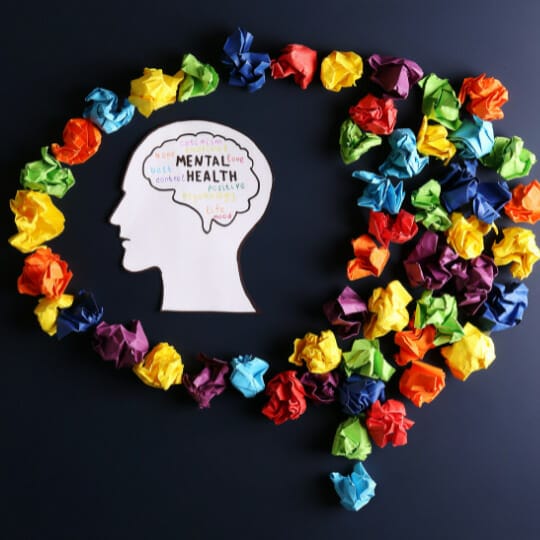
Mental illness is a significant global issue. If we want to take a preventative approach, we need to understand the factors that lead to mental health issues.
In any one year, 1 in 5 Australians is affected by diagnosed and undiagnosed mental health issues.
Mental health is a global issue, having the third highest disease burden of all diseases in Australia and globally. The World Health Organisation (WHO) predicts that depression (in particular) will be the leading health concern in both developed and developing nations by 2030[1].
We know that mental health issues affect a person’s thinking, emotional state and behaviour and disrupts their ability to work, carry out daily living activities and engage in healthy relationships. We also know that early, effective prevention or intervention programs maintain good mental health[2].
In that sense, if we can understand the causes and etiology of mental health issues, we are better placed to reduce and manage them better.
If we are to intervene early and effectively to prevent mental health issues, where do we start?
A logical place is the link between stress and mental health. There is overwhelming evidence that stress is a precursor to mental health issues and is tightly linked to mental health decline. Stress is also strongly related to depression[3].
Since 15 – 45% of mental health issues are attributable to workplace conditions, understanding the workplace risk factors seems to be a logical next step[4].

One model of stress and ageing/disease suggests that an individual’s perception of stress and prolonged exposure to stress can change the brain, body and behaviour, all of which perpetuate a vicious cycle of excessive response, damage and poor recovery3.
In the brain, an enlarged amygdala and diminished hippocampus are related to memory loss, reduced learning ability, and depression. The longer a person is highly or chronically stressed or depressed, the smaller their hippocampus gets.[5]
In the body, elevated cortisol levels and a chronically active fight or flight response can cause symptoms such as elevated resting heart rate or blood pressure.
A chronically stressed person may change their behaviour to help them cope or adapt[6]. Behaviour changes may include decreased exercise and sleep, increased smoking, changes to diet and reduced adherence to medication, all of which contribute to mental and physical health decline.
In other words, an employee who faces stressors such as constant overwork, prolonged screen time, sedentary work behaviours, feeling pressure to work or respond to emails outside working hours, discrimination, bullying or harassment, constantly facing disgruntled customers or workers, or long/irregular working hours, is at risk of chronic stress, and both physical and mental health issues[7].
The initial signs of mental health decline in the workforce may be subtle and therefore hard to detect at first, but over time will become more obvious in terms of health metrics and behaviour change.
Chronic stress and mental health concerns in the workplace result in increased absenteeism reduced contribution and participation, reduced productivity, reduced cohesiveness and cooperation and high staff turnover.
There are concomitant increases in the cost of health services, insurance and supplementary employment benefits to the tune of $17.4bn per annum in Australia4.
As a starting point, the hierarchy of control is a useful framework to identify and reduce stressors in the workplace, and to reduce the risk and development of mental health issues.

If workplaces can eliminate, substitute, or reduce exposure to stress and mental health hazards, provide protection and treat the negative impacts, then we may start to see mentally healthier, happier workplaces.
But let’s go one step further.
We all know that prevention is better than cure. From a preventive standpoint, workplace programs and initiatives that are proven to build employee resilience and improve individual stress responses will create a workforce where employees cope well, bounce back better, are happier and more productive in their roles.
Mental health issues are a global concern, and they have a significant impact on both quality of life and workplace productivity.
An individual’s perception of stress and prolonged exposure to stress are key factors in the development of mental health issues, via changes in the brain, body and behaviour.
We know that workplace conditions are strongly linked to both chronic stress and the development of mental health issues. This provides us with a golden opportunity to get on the front foot by better managing existing risks and by taking preventive action to improve resilience and create healthier, happier workplaces.
[1] https://www.who.int/healthinfo/global_burden_disease/GBD_report_2004update_full.pdf?ua
[3] Epel, S. et al., (2018). “More than a feeling: A unified view of stress measurement for population science,” Front Neuroendocrinol, vol. 49, pp. 146-169, Apr 2018, doi: 10.1016/j.yfrne.2018.03.001.
[4] Carter, L and Dr Stanford, J (2021). Investing in Better Mental Health in Australian Workplaces. The Australia Institute, Canberra, ACT.
[5] Doidge, N. (2007). The Brain that Changes Itself. Scribe Publications, Melbourne, Australia.
[6] Cohen S, Janicki-Deverts D, Miller GE (2007). Psychological Stress and Disease. JAMA. 2007;298(14):1685–1687. doi:10.1001/jama.298.14.1685
[7] Johnson, a. et. al (2020) A review and agenda for examining how technology-driven changes at work will impact workplace mental health and employee wellbeing. Australian Journal of Management 2020, Vol. 45(3) 402–424
Understanding who you are and what you need will allow your business to thrive! If you’re truly ready to break old habits and get out of the rut I encourage you to check out the Habitology membership.
Learn more here:
© 2024 Melanie White